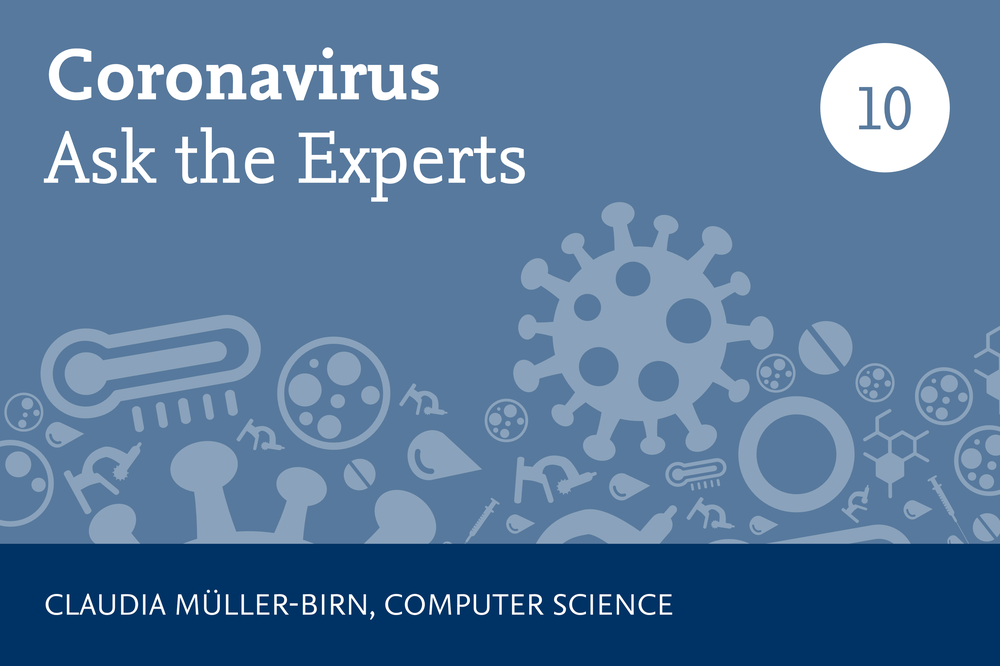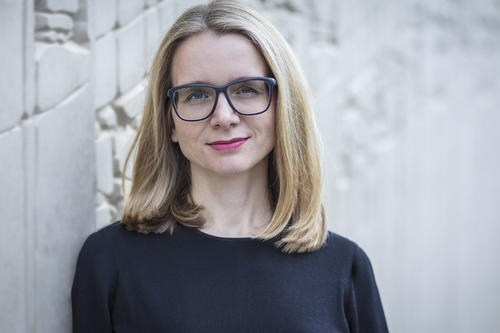“How should we design the tracing app so that people want to use it?”
campus.leben series: “Coronavirus – Ask the Experts” / Part 10: Claudia Müller-Birn, professor of computer science, discusses the development of the coronavirus-tracing app.
May 20, 2020
The app software should be designed to be participatory so that people understand the approach being used and trust it, says computer science professor Claudia Müller-Birn.
Image Credit: shutterstock.com/khaleddesigner
What changes has the coronavirus pandemic brought about? How has it influenced the lives of individuals? What impact is it having on society, politics, the economy, research, and culture? People have been talking about the launch of a coronavirus-tracing app for several weeks now. The idea is for a mobile app that uses Bluetooth technology to trace social contacts and that informs people who were in contact with someone who reports being infected. Leon Holly spoke with Claudia Müller-Birn, professor of computer science and director of the “Human-Centered Computing” research group at Freie Universität Berlin, about the app’s development.
Professor Müller-Birn, in early April virology professor Christian Drosten said, “An app could be almost as effective as an actual lockdown.” Do you, as a computer scientist, agree with the virologist?
Professor Claudia Müller-Birn is Professor of Human-Centered Computing at Freie Universität Berlin’s Institute of Computer Science.
Image Credit: Personal collection
As Mr. Drosten himself has said already, this quote is often taken out of context. He prefaced the sentence by saying that a critical mass of people in Germany would need to use the app for it to be effective, namely 60 percent of the population. Any less than that and the app wouldn’t serve much of a purpose. The question is whether it would help in some instances if certain regions were able to reach that number and thus ease the burden of public health officials. We don’t have enough experience with it to know for sure.
How did they arrive at 60 percent?
A study at the University of Oxford used a simulation to determine the number. The researchers calculated different scenarios and compared how various use levels would affect infection rates. In order to reduce infections, we have to reach a certain number of users in the population.
How does the app work?
The basic idea behind the tracing app is that users are notified automatically if they have had contact with an infected person – thus relieving the public health department of having to notify people. The app determines a potential contact when users’ smartphones have been in close proximity of each other for a certain amount of time (about 15 to 20 minutes). Data, i.e. temporary IDs, is then shared via Bluetooth and saved locally. If someone later finds out that he or she is infected, everyone who has had contact with the person will be notified of their higher risk of infection.
It is not clear yet how the actual notification will work or how the probability of infection is calculated (length of contact duration, distance, etc.). With a central architecture, the probability is calculated on a server that also receives information about all the people who have been in contact. As opposed to a decentralized architecture that would not pass along contact information. In any case, the use of the app is supposed to be completely voluntary.
Compared to other countries, Germany is particularly cautious when it comes to data protection and the development of tracing apps. Will these misgivings about data protection make the app less effective? Or is it even a point of contention?
People like to bring up this apparent contradiction and you often hear the argument: “If we continue to discuss the issue too long, we will lose precious time.” But this is a question of fundamental rights and this case will set a precedent. That is why it is important for us to take our time and think critically about the pros and cons of each architectural approach.
Currently, there is a debate about the Bluetooth technology that the app uses. Or whether a central architecture is preferable to a decentralized one. With a central architecture, there is a greater danger that unauthorized individuals might be able to access users’ personal data. With a decentralized approach, you run the risk of imprecise calculations, which means that people will not want to use the app anymore because they have received too many false warnings.
The German Federal Government decided to pursue a decentralized solution – a decision I support. Thus, in my opinion, the focus of the debate needs to shift at this point.
What do you think we should be addressing?
We have to go back to the actual question here: How should we design the app so that people download it and use it? We need to give more thought to how we can design the software to be participatory so that people understand the approach being used and build trust in it as they use it. One place we could start would be to provide explanations of the data protection measures being used. In addition, the tracing app could help people think about their own behavior.
Computer scientists, virologists, and politicians are joining forces to develop the app. How should they work together to make sure that the population is properly informed?
In the area of Human Computer Interaction, we would conduct a participatory study for a case like this in order to better understand people’s needs and to find out what they expect from this use of a technology. But that’s difficult because the federal government wants to have the app ready as soon as possible, if not sooner. The necessary surveys and studies on the tracing app will have to be done later on. In a software project with my students, I would like to start to close this gap.
What do you hope to achieve?
Freie Universität has declared this digital summer semester a “semester of creativity.” I would like to make it a “semester of solidarity” as well. Rather than just teaching the regular content, my team has been thinking about what we can do this semester that allows us to use our knowledge to help our society.
The source code of the tracing app is supposed to be accessible to everyone and therefore published as open source software. In the context of the software project, my students and I want to concentrate on potential users of the app and develop explanations about data protection measures. We also had the idea of letting users know how well they are complying with distancing rules, so that they can reflect on their behavior and potentially change it. People can follow our progress on our GitHub repository, which is open to the public.
That is a good way to increase transparency and possibly boost acceptance of the app. But the question of how accepting people will be is hard to separate from technical questions: For example, let’s imagine a retired person who does not own a smartphone. One idea was to provide a keychain fob with Bluetooth technology as an alternative. The keychain fob can collect and send data, but it can’t inform its owner in the same ways that a smartphone app can.
In Human Computer Interaction, we call this an “edge use case.” They are also important, and we need to find solutions for these types of cases.
In order to do so, we need to reflect on the two approaches to software development: the so-called waterfall model and agile development. In the waterfall model, at the beginning the requirements and expectations are written down in great detail, and they serve as the basis for developing the app. With agile development, you start with the most important requirements; after development and release, you check the app’s effectiveness in terms of usability and continuously make improvements.
My hope is that we use agile development with the coronavirus tracing app in order to address “edge use cases” in the medium term.
Since there is no blueprint for our current situation, we’ll have to be agile.
We don’t even know if an app will actually work. They have run simulations, but there haven’t been any user studies.
Would it be better to lower expectations instead of advertising the app as the solution?
An app alone can’t provide the solution. It is just one building block among many others. We will only find out whether it will work or not, when using it in the current political and social context.
Leon Holly conducted the interview.
The original German version of this article was published on May 12, 2020, in campus.leben, the online magazine of Freie Universität Berlin.
Further Information
Read all the interviews in the campus.leben series “Coronavirus – Ask the Experts”:
- Interview with Tanja Börzel: “The European Union has proven its resilience in times of crisis”
- Interview with Eun-Jeung Lee: “Many countries are now trying to learn from the Korean experience”
- Interview with Joachim Trebbe: “We are communicating more than usual in bubbles”
- Interview with Stefan Gosepath: How Just is Our Society in Times of Crisis?
- Interview with Carolin Auschra: “Organizations and systems often change in times of great crisis”
- Interview with Hansjörg Dilger: “The coronavirus pandemic is a mirror of globalization and the inequalities it has produced”
- Interview with Lars Gerhold and Roman Peperhove: “Everyone is potentially affected, but everyone can also do something”
- Interview with Paul Nolte: “We are going to be working through this trauma for decades to come”
- Interview with Martin Voss: “If we choose to, we can lay the groundwork to shape the future”


